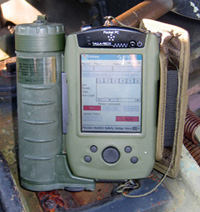Force XXI Battle Command Brigade and Below: Difference between revisions
imported>Howard C. Berkowitz No edit summary |
imported>Joe Quick mNo edit summary |
||
| Line 7: | Line 7: | ||
* Hazards and obstacles | * Hazards and obstacles | ||
Users can send text warnings and alerts. It can interface to vehicle-level systems such as Inter-Vehicle Information System, so soldiers in an armored fighting vehicle can know not just the location of friendly forces near them, but their fuel and ammunition reserves, their speed and course, and other information to improve cooperation and decrease the risk of [[fratricide]]. Smaller computer platforms can be issued to individual soldiers. | Users can send text warnings and alerts. It can interface to vehicle-level systems such as Inter-Vehicle Information System, so soldiers in an armored fighting vehicle can know not just the location of friendly forces near them, but their fuel and ammunition reserves, their speed and course, and other information to improve cooperation and decrease the risk of [[Fratricide (military)|fratricide]]. Smaller computer platforms can be issued to individual soldiers. | ||
[[Image:Pocket-Sized Forward Entry device for Artillery.jpg|left|thumb|pocket-sized artillery fire request device]] | [[Image:Pocket-Sized Forward Entry device for Artillery.jpg|left|thumb|pocket-sized artillery fire request device]] | ||
Another soldier-level device is the Pocket-Sized Forward Entry Device (PFED), which is a ruggedized Personal Digital Assistant that soldiers, at all levels, can send [[artillery]] fire support requests to [[Advanced Field Artillery Tactical Data System]] (AFATDS). It both speeds the call for fire, shows the soldier the material for double-checking, and lowers the chance of error. | Another soldier-level device is the Pocket-Sized Forward Entry Device (PFED), which is a ruggedized Personal Digital Assistant that soldiers, at all levels, can send [[artillery]] fire support requests to [[Advanced Field Artillery Tactical Data System]] (AFATDS). It both speeds the call for fire, shows the soldier the material for double-checking, and lowers the chance of error. | ||
Revision as of 13:30, 29 May 2009
Force XXI Battle Command Brigade and Below is among the first user-friendly U.S. Army command and control networked computer systems.
A basic display will show the relevant map, containing
- Enemy positions
- Friendly positions
- Hazards and obstacles
Users can send text warnings and alerts. It can interface to vehicle-level systems such as Inter-Vehicle Information System, so soldiers in an armored fighting vehicle can know not just the location of friendly forces near them, but their fuel and ammunition reserves, their speed and course, and other information to improve cooperation and decrease the risk of fratricide. Smaller computer platforms can be issued to individual soldiers.
Another soldier-level device is the Pocket-Sized Forward Entry Device (PFED), which is a ruggedized Personal Digital Assistant that soldiers, at all levels, can send artillery fire support requests to Advanced Field Artillery Tactical Data System (AFATDS). It both speeds the call for fire, shows the soldier the material for double-checking, and lowers the chance of error.
Armored fighting vehicles equipped with it include the M1 Abrams and M2 Bradley.
The portable AN/PSC-5 radio, which is man-portable and well as usable on aircraft, vehicles, ships and in base stations, can provide connectivity for FBCB2.

